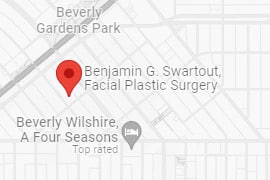
Are you considering reshaping your nose to better reflect your cultural identity? Ethnic rhinoplasty is a specialized approach to nose surgery that respects the diverse aesthetic features unique to different ethnic backgrounds. However, like any surgical procedure, it comes with its own set of considerations.
Renowned for his expertise in facial plastic surgery, Beverly Hills plastic surgeon Dr. Benjamin Swartout provides patients with results that honor their ethnicity while maintaining natural beauty and function. His comprehensive understanding of facial anatomy, paired with a culturally sensitive approach, minimizes risks, ensuring a safe and satisfying transformation.
The Pursuit of Cultural Harmony: Understanding Ethnic Rhinoplasty Surgery
Ethnic Rhinoplasty respects the fine line between improving the appearance and keeping the unique ethnic characteristics that speak to a person’s cultural roots. A plastic surgeon with expertise in facial plastic surgery considers a patient’s heritage when working on the nasal bridge or nostril size and shape. The goal is to enhance the nose while still preserving ethnic identity.
Patients want a nose that meets their aesthetic goals and shows their cultural background. The rhinoplasty technique used should be personalized to their facial features. Ethnic rhinoplasty surgeons strive to create balance and symmetry, ensuring the results fit well with the rest of the face without removing ethnic markers.
Different ethnic groups have unique nasal shapes. For example:
- Black patients (African and Afro-Caribbean) might have a broad nasal bridge, thicker skin, and wide nostrils.
- Asian patients often have a flatter nasal bridge and a rounded tip.
- Middle Eastern patients, as well as Hispanic patients, may show a prominent nasal bridge and sharp tip.
A good plastic surgeon values these features instead of trying to hide them, honoring diversity and giving natural-looking results that stay true to the patient’s origins. Ethnic Rhinoplasty isn’t just about changing a nose; it’s about affirming cultural identity and celebrating human diversity.
By focusing on the natural variation in nasal features, traditional rhinoplasty can accentuate a person’s look appropriately. It’s not about aiming for an ideal nose or using a one-size-fits-all approach but about customizing this specialized procedure to each individual. This enhances the ethnic rhinoplasty patient’s natural beauty without losing a connection to their heritage.
2. The Decision Factor: Reasons People Opt for Ethnic Rhinoplasty
An ethnic nose job is not only about changing one’s appearance; it’s a significant step for many to enhance their confidence. By getting a nose job that considers their ethnical background, individuals can achieve a look that reflects their identity. These types of procedures allow people to improve their nose’s shape or size while preserving their ethnic traits, which can greatly boost their self-image.
Aside from solving cosmetic flaws, nose surgery also has health benefits, such as correcting breathing difficulties tied to natural nasal passage shape or injuries to the nasal septum. Reconstructive surgery during rhinoplasty can increase the nasal airways, which is vital for both physical comfort and overall well-being. By resolving these breathing concerns, individuals can enjoy a better quality of life with uninterrupted airflow.
Overall, Ethnic Rhinoplasty contributes to both the functionality and aesthetic harmony of facial features, reinforcing the importance of personalized healthcare interventions.
3. Tailored Approach: The Importance of Finding a Specialist
Experience in Ethnic Rhinoplasty
Choosing a plastic surgeon with significant experience in ethnic rhinoplasty is crucial for patients who want a procedure that honors their individuality. A specialist understands the specific facial characteristics of different ethnicities and applies this knowledge to achieve results that naturally enhance each patient’s features. This gives the rhinoplasty patient confidence, as they can trust they are in the hands of someone who appreciates cultural aesthetics.
The Difference a Specialist Makes
The quality of outcomes in rhinoplasty surgery strongly reflects the surgeon’s expertise. A specialist offers several benefits:
- Skills customized to tackle distinctive structural features.
- Methods to handle the variety of healing processes.
- An artist’s vision is to maintain the essence of the patient’s ethnic background.
Therefore, choosing an experienced surgeon who is a specialist in ethnic rhinoplasty is essential for a result that matches the patient’s expectations and preserves their ethnic heritage. Patients choosing a specialist are selecting accuracy, safety, and a mutual understanding of their aesthetic objectives.
4. Inherent Risks: Common Complications Associated with Ethnic Rhinoplasty
Ethnic rhinoplasty carries the risk of scarring. Darker skin tones often show scars more easily. There’s also the chance of pigmentation issues, where the skin changes color around the surgery site. This means surgeons need to adapt their methods for different patients.
Skin type and ethnicity impact the results. Thin skin may show imperfections, while thick nasal skin can reduce the definition of the new nose shape. Complications may include:
- Noticeable scar tissue changing the look of the nose
- Trouble getting the right shape because of skin thickness
- Higher chance of nasal trauma if the structure isn’t strong enough
Those getting a primary rhinoplasty or revision rhinoplasties must consider these issues. A surgeon’s skill in dealing with ethnic skin is vital to lowering risks and getting a good result.
5. Measuring Expectations: The Realistic Outcomes of Ethnic Rhinoplasty
Ethnic nose surgery is often about cultural sensitivity alongside aesthetics and function. Patients can anticipate a result that honors their ethnicity and meets their personal goals post-surgery. Realistic expectations might include a balanced and proportional nose, maintained or highlighted ethnic features, improved nasal function, and a recovery phase with some swelling and bruising.
Understanding that the nose job is a complex cosmetic surgery, and it may take a year to see the final effect is crucial. Patients should recognize that the healing process is gradual.
A pre-surgery consultation is crucial for ensuring patient rights and informed consent for an ethnic rhinoplasty procedure. Surgeons should hold virtual consultations and utilize imaging techniques to outline possible outcomes. This allows patients to visualize post-surgery results and set realistic expectations.
The ethnic rhinoplasty consultation should also involve:
- Discussing aesthetic and functional goals.
- Advising based on facial structure.
- Presenting simulations through imaging.
- Communicating risks and achievable outcomes.
These steps foster a sense of trust and preparedness for patients ahead of their rhinoplasty procedure.
6. Recovery and Support: Navigating the Post-Operative Phase
Recovering from an ethnic rhinoplasty takes time and careful attention. The recovery process starts from the moment surgery ends, with the initial weeks being pivotal for controlling bruising and swelling. Here’s a simple timeline to guide you through:
- First Week: Brace for significant bruising and swelling. Ice packs can help ease discomfort and keep swelling down. Sleep with your head raised to lessen puffiness.
- Second Week: Bruising begins to fade. To preserve facial symmetry, it’s crucial to avoid risky activities that might harm your nose.
- Third to Fourth Week: Swelling keeps going down. Cleaning the area gently is important to prevent infection and aid the healing process.
- Months After Surgery: Full recovery might take a few months while subtle improvements and final touches on facial symmetry take shape. Protecting your skin from the sun is very important to avoid dark spots.
Stick with the advice given by your surgeon for a smooth recovery process, as each person’s experience could be different.
Support systems are invaluable during the recovery process, offering both emotional and practical help. Here’s how they can assist:
- They can drive you to follow-up appointments.
- They can help track your medicines and look for any signs of problems.
- Emotional backing is important since adjusting to changes in how you look can be tough.
- They can do chores, letting you focus on rest and recuperation.
With encouragement from friends and family, you’re more likely to have a positive mindset and a successful healing process after your rhinoplasty. Success in the weeks following your procedure is deeply connected to the care and assistance you receive from your close ones.
Assessing Personal Values Against Surgical Risks
Before choosing ethnic rhinoplasty, it’s crucial to balance the pros and cons. Patients should think about how the benefits meet their values and if they are worth the risks. A closed rhinoplasty is popular for less scarring and preserving ethnic traits. But, possible dangers like anesthesia issues, infection, or unhappiness with the results can’t be ignored.
Think about how much you value the changes in your nose’s look versus the risk of problems. For those with a broken nose or breathing trouble, nose job surgery may be more valuable for its functional benefits.
The Critical Role of Patient Education in Surgical Outcomes
Knowing about surgical techniques, especially the details of a closed rhinoplasty approach, is key to good results. Talking with a surgeon about the closed rhinoplasty approach gives insights into recovery, complications, and what to realistically expect.
Patients who understand what’s involved often have better results. They’re more likely to follow after-care steps, communicate with their doctor, and be happier with the outcome, which reduces the chance of needing more surgeries.
Keeping patients informed helps them prepare for the changes and the recovery process. It bridges the gap between hopes and real-life results through knowledge.
Ethnic rhinoplasty involves a critical decision that affects not only beauty but health. It requires:
- Considering options for grafts and filler.
- Protecting nasal bones and reshaping nasal cartilage.
- Minimizing post-surgery activity to avoid complications and too much sun exposure.
Outcomes rely on matching the right type of tissue—whether it’s strengthening with grafts or soft tissue enhancement with filler. Proper care in the recovery period ensures optimal healing. The goal is to enhance features without losing individuality, respecting each unique appearance.
Ethnic rhinoplasty offers profound changes without overdoing it. It’s about thoughtful choices, from the extent of reduction to managing sun exposure and activity, ensuring no compromise on care.
Embarking on your ethnic rhinoplasty journey requires thoughtful consideration, and the right specialist makes all the difference. Serving patients from Beverly Hills and Southern California, Dr. Benjamin Swartout combines cultural sensitivity with unparalleled skill, ensuring your results celebrate your cultural features and family heritage.
Ready to explore how you can enhance your natural beauty while honoring your cultural heritage? Schedule your consultation with Dr. Swartout today, and take the first step towards a personalized experience tailored to your unique features and desires.

